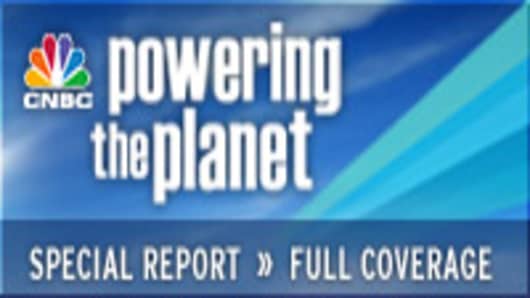Solar Thermal Electrical Generation (STEG) devices concentrate the sun’s thermal energy by mirrors or lenses to create intense heat, driving a steam-driven generator. The machines shave storage capacity to deliver steady round-the-clock electricity like conventional power plants.
How big is the market?
Some 2.6 gigawatts of new photovoltaic capacity was installed in 2007 — a 40 percent jump from 2006 — fueled by $7.1 billion in investment ($2.8 billion from VC and private equity; the balance from quoted companies). Growth has averaged 40 percent a year since 2000.
Total worldwide PV installed capacity is concentrated in a handful of countries; roughly 90 percent is in the US, Japan, Spain and Germany, which have subsidies in place to bring this increasingly mature technology to a point of cost-competitiveness. For crystalline silicon PV, that's thought to be achievable within five years; for the more efficient thin-film and concentrator technologies, that hallmark may come sooner.
Although the "fuel" for solar power is limitless, the industry has been laboring under a shortage of silicon, which is expected to ease with new production coming on-line this year and next. Despite its dramatic growth, solar satisfies less than one percent of global electricity demand.
Where is solar used the most?
Although the US has some of the best solar resources (see map), Germany has installed eight times more PV because of generous incentives. Germany is currently home to more than 40 percent of total global capacity, four times the US.
Japan is also a major force at 9 percent of global capacity. France, Italy, South Korea and Spain have also become important markets.
The US, spurred by state and federal incentives, continues to post strong growth. In the last year, there's been a 74-percent increase in PV manufacturing and a 45-percent increase in installations. As impressive as that sounds, total output is just 150 MW, equal to a third of the size of a standard coal plant.
More than 12,700 power-producing sites connected to the US grid in 2007. California dominates the market with 58 percent of total capacity. Elsewhere, installations grew more than 80 percent, led by Nevada, Colorado, Hawaii, Oregon, Connecticut and New Jersey.
Who's Using It?
Particularly important in driving installation is the trend of big-box stores going green. Wal-Mart announced plans to install solar panels at 24 stores in California and Hawaii, while Best-Buy said it would be doing the same at 35 US stores.
Plans bySafeway , Whole Foods, Staples, Target, Home Depot, Macy’s and Costco for similar installations will almost certainly be affected by whether an investment tax credit (which allows a 30 percent write-off) is extended beyond the end of 2008.
Who are the major players and in the various market segments?
The biggest crystalline silicon cell makers are Sharp, Kyocera , the solar unit of BP, Suntech , Motech and Q-Cells , while the less technically-efficient but cheaper thin-film market is dominated by First Solar and United Solar, a wholly-owned subsidiary of Energy Conversion Devices .
Thin-film production accounts for just 11 percent of worldwide production, but it plays a much more important part of the US PV industry — roughly 30 percent. The US has about half of global thin-film capacity, which is fast approaching cost parity with other forms of energy.
Almost all major PV manufacturers continue to expand production. First Solar’s expansion in Malaysia will help push its annual capacity to 1 gigawatt by the end of 2009. SunPower of California has added more than 625 megawatt capacity at its Philippines facility, while Applied Materialshas moved aggressively into the sector in the past few years. Germany’s SolarWorld is aiming to reach 500 megawatt production by 2010, while Evergreen Solar continues to expand its US production and those in joint ventures with Renewable Energy and Q-Cells in Germany. Among listed pure play solar companies, Renewable Energy, First Solar, Q-Cells and SolarWorld rank, in that order, in terms of market capitalization.
What are future trends in the industry?
Besides a range of next-generation technologies for which US companies are well-placed, the most dynamic future segment in solar is STEG, which has attracted more than $400 million in VC investment so far this year. Though there is currently just 426 megawatts of installed capacity projects, developers in Spain and a number of Southwestern states are planning to build more than 6 gigawatts of projects worth at least $24 billion. A recent report by the Western Governor’s Association identified regional STEG potential of 200 gigawatts, about a fifth of US generation capacity.




